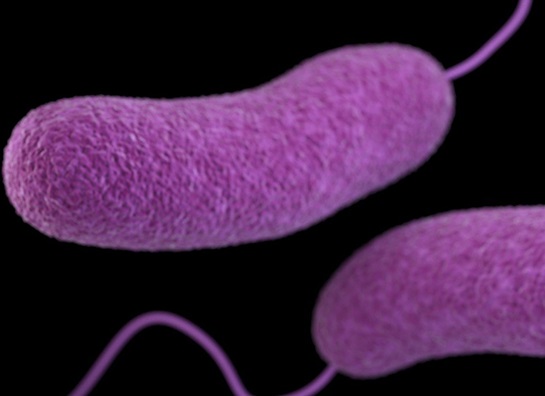Vibriosis
 Vibrio is a genus of Gram-negative bacteria shaped as a curved rod with a single polar tail. Bacteria belonging to the species Vibrio do not form spores and are facultative anaerobes
Meaning an organism that makes units of energy (ATP) by aerobic respiration when oxygen is present, but capable of switching to fermentation when oxygen is not present..
Vibrio is a genus of Gram-negative bacteria shaped as a curved rod with a single polar tail. Bacteria belonging to the species Vibrio do not form spores and are facultative anaerobes
Meaning an organism that makes units of energy (ATP) by aerobic respiration when oxygen is present, but capable of switching to fermentation when oxygen is not present..
There are a few species of vibrio that are human pathogens are V. parahaemolyticus, V. vulnificus, and V. alginolyticus. V. cholerae is another species that is associated with pandemic outbreaks caused by contaminated drinking water is discussed separately.
According to the CDC, Vibriosis causes an estimated 80,000 illnesses and 100 deaths in the US every year, and the prevalence of these infections have increased about 75% since tracking began in 1996, especially in the Gulf states Gulf States – include Alabama, Florida, Louisiana, Mississippi and Texas. This is where a lot of the sea food consumed in the US is farmed and harvested..
People with vibriosis become infected by consuming raw or undercooked seafood especially shellfish, or when wounds exposed to salt water become infected.
V. parahaemolyticus and V. vulnificus, are usually found in the warm shallow coastal salt water in temperate climates throughout most of the world including the Gulf of Mexico, along most of the East Coast and along all of the West Coast of the United States. These bacteria can be found in brackish Brackish water is found in areas where salt and fresh water mix together, mostly estuaries. It contains more saline that fresh water, but less than salt water. Some familiar locations of brackish water include –Hudson River, NY; East and Harlem rivers, NY; Lakes Charles and Pontchartrain in Louisiana; San Francisco Bay; Lake Texoma on the OK, TX border) and Chesapeake Bay (the largest estuary in the US). and salt water, sediment, plankton, and shellfish, e.g. oysters, clams, and crabs. Some seafood that lives in brackish water includes salmon, herring, bull shark, striped bass, tilapia and trout.
V. alginolyticus , a species more tolerant of salt water, is found in the puffer fish used to make the Japanese delicacy, Fugu sashimi. It produces a neutrotoxin- tetrodotoxin – that is more deadly than cyanide.
Symptoms usually occur within 24 hours of consuming contaminated food, and include explosive watery or bloody diarrhea, abdominal cramps, nausea, vomiting, fever, and chills – gastroenteritis. Symptoms can last up to 3 days. Symptoms can be much more serious to those with weakened immune systems.
The most recent infection (2018) was linked to fresh imported crab meat, and in 2013 a larger infection was linked to shellfish harvested from the Atlantic coast.
Although less common than food borne infections, Vibrio bacteria, especially V. alginolyticus can also cause a ear infections and severe skin infections when an open wound is exposed to brackish or salt water.
To reduce the incidence of illness, all safe food handling practices should be observed – including hand washing, refrigeration and storage. Shellfish should be shucked and boiled for at least 3-5 minutes or fried at 375 degrees for 10 minutes. In the case of puffer fish, it should only be eaten if prepared by a well trained expert.
Although treatment is not necessary in mild cases of Vibriosis, as with any gastroenteritis infection, those infected should drink plenty of liquids to replace fluids lost through diarrhea. There is no evidence that antibiotics decrease the severity or duration of illness but are sometimes used in cases of severe or prolonged illnesses.
During the summer months when the bacteria thrive in the warmer waters, many coastal jurisdictions are vigilant in their efforts to prevent illnesses associated with this organism. In Massachusetts there is a structured program in place to educate the public about this preventable disease.
In Washington State, where at times beaches are closed because of contaminated oysters, there are also rules and presentations addressing procurement and consumption of shellfish.
Check here to see more information about Vibrio alerts in other coastal cities that you may visit during the summer.
Learn more about Vibriosis and how to protect yourself at: https://www.cdc.gov/vibrio/
Additional References:
Clinical Microbiology made ridiculously simple. Edition 3. Mark Gladwin, M.D. and Bill Trattler, M.D.
https://emedicine.medscape.com/article/1055523-overview